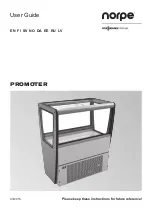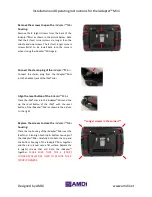
iGiC-ism-0608
8
Plumbing
Waste Outlet and P-TRaP
The waste outlet is located off the center of the case on
one side allowing drip piping to be run lengthwise under
the fixture.
A 1-1/" P-TRAP and thread adapter are supplied with
each fixture. The P-TRAP must be installed to prevent air
leakage and insect entrance into the fixture.
nOTe: PvC-dWv solvent cement is recommended. Follow the
manufacturer’s instructions.
installing Condensate drain
Poorly or improperly installed condensate drains can
seriously interfere with the operation of this refrigerator, and
result in costly maintenance and product losses. Please
follow the recommendations listed below when installing
condensate drains to insure a proper installation:
1. Never use pipe for condensate drains smaller
than the nominal diameter of the pipe or P-TRAP
supplied with the case.
. When connecting condensate drains, the P-TRAP
must be used as part of the condensate drain
to prevent air leakage or insect entrance. Store
plumbing system floor drains should be at least 14"
off the center of the case to allow use of the P-TRAP
pipe section. Never use two water seals in series in
any one line. Double P-TRAPS in series will cause a
lock and prevent draining.
3. Always provide as much down hill slope ("fall") as
possible; 1/8" per foot is the preferred minimum.
PVC pipe, when used, must be supported to
maintain the 1/8" pitch and to prevent warping.
4. Avoid long runs of condensate drains. Long runs
make it impossible to provide the "fall" necessary for
good drainage.
5. Provide a suitable air break between the flood rim of
the floor drain and outlet of condensate drain. 1" is
ideal.
6. Prevent condensate drains from freezing:
a. Do not install condensate drains in contact with
non-insulated suction lines. Suction lines should
be insulated with a non absorbent insulation
material such as Armstrong's Armaflex.
b. Where condensate drains are located in dead
air spaces (between refrigerators or between a
refrigerator and a wall), provide means to prevent
freezing. The water seal should be insulated to
prevent condensation.
Refrigeration
Refrigerant Type
The standard refrigerant will be R-404A or R unless
otherwise specified on the customer order. Check the serial
plate on the case for information. Minimum opening for self
contained condenser units - 150 sq. inch up to 1-1/ hp,
00 sq. inch for over 1-1/hp.
Refrigeration lines
Liquid
Suction
3/8” O.D.
5/8” O.D.
nOTe: The standard coil is piped at
5
/
8
” (suction); however,
the store tie-in may vary depending on the number of
coils and the draw the case has. depending on the case
setup, the connecting point in the store may be
5
/
8
”,
7
/
8
”,
or 1
1
/
8
”. Refer to the particular case you are hooking up.
Refrigerant lines should be sized as shown on the
refrigeration legend furnished by the store.
Install
P-TRaPs
(oil traps) at the base of all suction line
vertical risers.
Pressure drop
can rob the system of capacity. To keep the
pressure drop to a minimum, keep refrigerant line run as
short as possible, using the minimum number of elbows.
Where elbows are required, use long radius elbows only.
Control settings
See ISM technical data sheet for the appropriate settings for
your merchandiser. Maintain these parameters to achieve
near constant product temperatures. Product temperature
should be measured first thing in the morning, after having
been refrigerated overnight. Defrost times should be as
follows: OFF CYCLE - Defrost times should be as directed
in the ISM technical data sheet. The number of defrosts per
day and the duration of the defrost cycle may be adjusted
to meet conditions present at your location.
access to TX valves and drain lines
mechanical -
Remove product from end of case. Remove
product racks. Remove refrigeration and drain access
panels (labeled). TX valve (mechanical only) and drain are
located under each access panel at end of the case.
electronic -
The Electronic Expansion valve master and
slave cylinder(s) are located within the electrical access
panel(s).
electronic expansion valve (Optional)
A wide variety of electronic expansion valves and case
controllers can be utilized. Please refer to EEV and
controller manufacturers information sheet. Sensors for
electronic expansion valves will be installed on the coil inlet,
coil outlet, and in the discharge air. (Some supermarkets
require a 4th sensor in the return air). Case controllers will
be located in the electrical raceway or under the case.























